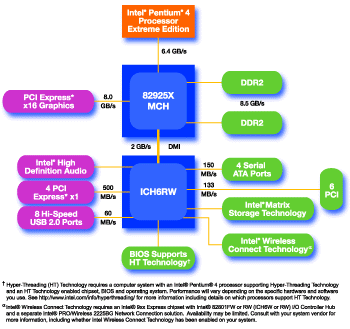The 925X chipset is Intel's current high-end
'enthusiast' part, taking the place of the i875P chipset. In addition to the
features that it shares with the 915 chipset, the 925X was the first chipset to
support the 1066MHz frontside bus processors when they first became available.

The 925X supports dual-channel DDR2 memory and PCI
Express graphics solutions only, dropping the mainstream flexibility of the 915
parts in favour of increased performance.
Like its sister chipset, the 925X uses the ICH6
Southbridge chip, often the '-R' version with RAID support given the target
market of enthusiasts and power users. Intel's 8-channel High Definition Audio
is also a standard.
More on the ICH6
Southbridge
Intel's ICH6 Southbridge chip represents several steps
forward in terms of design. It introduced support for several features, most
significantly PCI Express in the form of four PCI Express 1X channels. This
allows manufacturers to add as many as four PCI Express 1X slots onto
motherboards, in addition to the standard PCI expansion slots. The Southbridge
does not support gigabit Ethernet internally, settling for the standard 10/100
instead.
Elsewhere, it becomes obvious that Intel intended the
915 and 925X to run mostly with Serial ATA hard drives, as the standard ICH6
chip supports four channels of serial ATA and only a single IDE channel intended
mostly for optical drives. Many manufacturers have chosen to bolt on various
add-on IDE controllers, since the older standard seems to be a long way from
disappearing. The serial ATA ports will use Intel's new AHCI (Advanced Host
Controller Interface).
Eight USB 2.0 ports are supported, a number that should
satisfy most any user's requirements. Legacy PCI ports are also supported. The
ICH6 Southbridge uses an entirely new interface to pass data to the Northbridge
chip. The large amount of new interfaces that the Southbridge supports
necessitated this to avoid data bottlenecks. Intel's DMI (Direct Media
Interface) is a serial point-to-point connection somewhat similar in approach to
PCI Express, and delivers comparable (and much needed) bandwidth improvements,
to the tune of 2GB/s.
A few variants to the standard ICH6 are also available:
The ICH6-W, ICH6-R and ICH6-RW. The most interesting of these is the ICH6-W
version, which adds wireless access point functionality to the chipset. While
the Southbridge does not include an actual wireless transmitter (users need to
purchase a wireless network card or a motherboard which has one built in), when
it is attached to one, the computer can act as the 'hub' to a wireless home or
business network, killing several birds with one stone. Sensibly, Intel has
indicated that this feature will be turned off by default on supporting
chipsets, since while convenient, it also creates a huge security risk for users
who are not aware of wireless networking procedures.
The ICH6-R is the RAID oriented version of the
Southbridge, and adds support for RAID 0,1 and 0+1 modes. This offers excellent
performance and data security possibilities for home users. (For more
information on RAID see PCSTATS' Guide). The ICH6-RW chip brings all of the
above features together.
 More on PCI
Express
More on PCI
Express
(for an in-depth look at this subject, see our article
on PCI Express technology here.)
PCI Express is a data bus technology that uses matched
pairs of point-to-point serial connections to carry data. Each wire carries data
in one direction only. The data connections can be stacked to provide higher
bandwidth links. A PCI Express x1 connection would have a single pair, for
example, giving a total bandwidth of 2.5Gb/s. A PCI Express x2 or PCI Express x4
connection would have double or quadruple the amount of pairs respectively,
increasing maximum bandwidth.
PCI Express is intended to adopt several roles within
modern chipsets and motherboards. Most significantly, PCI Express 16X links at
4-5GB/s bandwidth are in the process of replacing the AGP 8X standard. The 915
and 925X are the flagships for this technology, and were the first to use this
new connector instead of the AGP 8X slot. PCI Express 16X provides significantly
more bandwidth, allowing video card manufacturers more headroom to improve
graphics performance in the future.
PCI Express 1X slots are now integrated into 915 and
925X motherboards alongside the more familiar PCI slots. The increased data
handling capacity of these connectors will allow standard desktop PCs to use
high-bandwidth peripherals like Gigabit Ethernet cards without needing a
specialized interface.
More on DDR2
(for an in-depth look at how DDR2 memory functions, see
our technology preview here)
As we mentioned, DDR2 is an incremental improvement to
the current DDR standard, not a radical one. The problem with DDR is that it
becomes difficult and expensive for manufacturers to make DDR memory rated for
higher speeds than 200MHz (DDR-400), since the margin for error decreases as the
speed rises. DDR2 solves this problem by reducing the speed at which the memory
runs internally by half, but doubling the amount of data that is moved from the
core memory to the external memory bus. This allows memory makers to keep
ramping up the speed of the memory externally, while the lower internal speed of
DDR2 keeps costs down and yields high.
The only downside to this is that DDR2 does not present
any actual performance improvement over DDR, at least not currently. Its only
advantage is its ability to support higher memory speeds. DDR2 memory is already
available from major memory manufacturers, though costs are still sky high. Look
for them to drop considerably once the major chipset manufacturers manage to get
AMD 64 DDR2 chipsets out.
